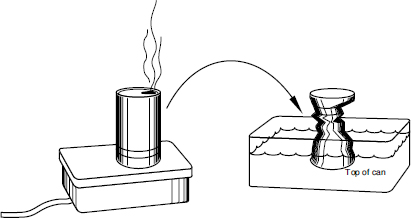

The Weight of Air
Theme: The Bible is accurate in every single detail, including scientific ideas.
Bible Verse: For He looks to the ends of the earth, and sees under the whole heavens, to establish a weight for the wind, and apportion the waters by measure. (Job 28:24–25)
Materials Needed:
• Glass of water
• Paper plate or index card
• Hot plate
• Empty soda cans
• Pot holder or tongs
• Tray of cool water
Bible Lesson
In this technical age it is often assumed that the Bible is outdated and prescientific in its content. After all, Scripture was written more than two thousand years ago, long before modern scientific discoveries. In truth, however, God’s Word is found to be entirely accurate, even in the smallest details.
Job 28:24–25 declares that God established the earth’s wind and water. The entire chapter describes the source of real wisdom: knowing the Creator who made all things. The “weight [or force] of the wind” is a phrase that accurately describes the heaviness of air. If air had no weight, then the wind could have no force. If this were the case, barometers would read zero pressure. Instead, the air above us exerts an average pressure of 2,100 pounds upon each square foot at the earth’s surface, or about 15 pounds per square inch. Job 28, written long before the modern concept of pressure, is entirely correct in referring to the force or weight of the wind. The Bible is indeed trustworthy in every detail.
Science Activity
There are several ways to demonstrate air pressure or the weight of air. Two interesting methods will be described here. First, fill a glass with water, perhaps from a pitcher. Place a paper plate or index card over the top, and while holding it in place, tip the glass upside down. Now take your hand off the card and it should stay in place. (You may want to do this activity over a sink or dishpan in case of a spill.) The pressure of the air, actually pushing upward from underneath, is greater than the downward weight of the water in the glass. This activity works whether the glass is full or only partially filled with water. You must take care that the paper maintains a good seal, and do not tilt the glass.
The second method requires some preparation ahead of time. Pour one to two inches of water into several empty aluminum soda cans and place them on a hot plate. The water needs to be heated to the point of gently boiling, with steam rising from the openings. When ready, pick up a can with a pot holder or small tongs and tip it upside down into the tray containing shallow water. This will seal the open end of the can below the water level and will also quickly cool the steam inside the can. The activity works best if the water in the tray is cold, perhaps with some ice cubes. As the steam condenses, a vacuum develops within the can. The weight of the outside air will then rapidly crush the can with a loud snapping sound. Repeat the activity with the other cans, or let volunteers try the technique. The weight of the air, referred to in the book of Job, acts as a can crusher.

Water is brought to a boil in a soda can. When the can is inverted in a tray of cold water, it is crushed by air pressure.
Science Explanation
It may seem that the air is entirely weightless. However, each cubic foot of air actually weighs about one-tenth of a pound. The air in a typical room thus adds up to several hundred pounds.
Air exists for several miles above the earth, gradually thinning with altitude. Gravity keeps this air “attached” to earth. The weight of this air layer is what results in atmospheric pressure on the earth. The pressure exists in all directions; hence, it pushes upward on the card under the glass as well as against the sides of the aluminum cans in the activity.
Why are our bodies not crushed by the ever-present air pressure? We are not affected because we are an “open system.” By breathing air, we maintain largely the same pressure inside as outside our bodies. If we dive deeply into water, however, we quickly feel additional pressure from the weight of the water above us.